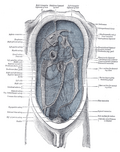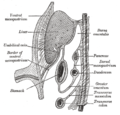Greater omentum
Greater omentum is a large apron-like fold of visceral peritoneum that hangs down from the stomach. It extends from the greater curvature of the stomach, passing in front of the small intestines and doubles back to ascend to the transverse colon before reaching to the posterior abdominal wall. The greater omentum is larger and fattier than its counterpart, the lesser omentum. It stores fat deposits and contains many lymph nodes.
Structure[edit]
The greater omentum is formed by a double layer of peritoneum. It consists of four layers, made by a double fold of the dorsal mesogastrium. The layers are fused, and the anterior two layers ascend to the greater curvature of the stomach and the beginning of the duodenum. The posterior two layers pass from the front of the transverse colon to its posterior aspect, where they separate and enclose the pancreas before reaching the posterior abdominal wall.
Function[edit]
The greater omentum plays several important roles in the body. It serves as an insulator and cushion to protect the abdominal organs. It also has immunological functions, as it contains milky spots of macrophage collections which can identify and combat foreign substances in the abdominal cavity. Additionally, the greater omentum can adhere to areas of inflammation or infection, walling off the infected area to prevent the spread of infection.
Clinical significance[edit]
In some cases, the greater omentum can become twisted, leading to a condition known as omentum torsion. This can cause severe abdominal pain and requires surgical intervention. The greater omentum can also be involved in various pathologies, such as omentum cancer, omentum cyst, and omentum infarction.
See also[edit]
References[edit]
<references />
|
|
|
-
Lesser omentum illustration
-
The greater omentum and its connections
-
The peritoneum and its reflections
-
The abdominal cavity
-
The mesentery and its folds
-
The greater omentum in situ
-
The stomach and its surrounding structures
-
The transverse colon and its mesocolon
-
The greater omentum and transverse colon
-
Greater omentum
Ad. Transform your life with W8MD's Budget GLP-1 injections from $75


W8MD offers a medical weight loss program to lose weight in Philadelphia. Our physician-supervised medical weight loss provides:
- Weight loss injections in NYC (generic and brand names):
- Zepbound / Mounjaro, Wegovy / Ozempic, Saxenda
- Most insurances accepted or discounted self-pay rates. We will obtain insurance prior authorizations if needed.
- Generic GLP1 weight loss injections from $75 for the starting dose.
- Also offer prescription weight loss medications including Phentermine, Qsymia, Diethylpropion, Contrave etc.
NYC weight loss doctor appointmentsNYC weight loss doctor appointments
Start your NYC weight loss journey today at our NYC medical weight loss and Philadelphia medical weight loss clinics.
- Call 718-946-5500 to lose weight in NYC or for medical weight loss in Philadelphia 215-676-2334.
- Tags:NYC medical weight loss, Philadelphia lose weight Zepbound NYC, Budget GLP1 weight loss injections, Wegovy Philadelphia, Wegovy NYC, Philadelphia medical weight loss, Brookly weight loss and Wegovy NYC
|
WikiMD's Wellness Encyclopedia |
| Let Food Be Thy Medicine Medicine Thy Food - Hippocrates |
Medical Disclaimer: WikiMD is not a substitute for professional medical advice. The information on WikiMD is provided as an information resource only, may be incorrect, outdated or misleading, and is not to be used or relied on for any diagnostic or treatment purposes. Please consult your health care provider before making any healthcare decisions or for guidance about a specific medical condition. WikiMD expressly disclaims responsibility, and shall have no liability, for any damages, loss, injury, or liability whatsoever suffered as a result of your reliance on the information contained in this site. By visiting this site you agree to the foregoing terms and conditions, which may from time to time be changed or supplemented by WikiMD. If you do not agree to the foregoing terms and conditions, you should not enter or use this site. See full disclaimer.
Credits:Most images are courtesy of Wikimedia commons, and templates, categories Wikipedia, licensed under CC BY SA or similar.
Translate this page: - East Asian
中文,
日本,
한국어,
South Asian
हिन्दी,
தமிழ்,
తెలుగు,
Urdu,
ಕನ್ನಡ,
Southeast Asian
Indonesian,
Vietnamese,
Thai,
မြန်မာဘာသာ,
বাংলা
European
español,
Deutsch,
français,
Greek,
português do Brasil,
polski,
română,
русский,
Nederlands,
norsk,
svenska,
suomi,
Italian
Middle Eastern & African
عربى,
Turkish,
Persian,
Hebrew,
Afrikaans,
isiZulu,
Kiswahili,
Other
Bulgarian,
Hungarian,
Czech,
Swedish,
മലയാളം,
मराठी,
ਪੰਜਾਬੀ,
ગુજરાતી,
Portuguese,
Ukrainian












